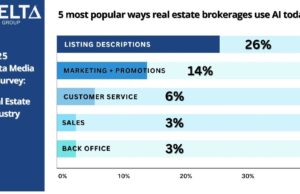Real Estate Economists Expect Continued Declines in Real Estate Growth Rates, According to a New ULI Semi-Annual Real Estate Market Survey
WASHINGTON – October 20, 2016 – (RealEstateRama) — Following six years of growth, commercial property transaction volume is expected to decline over the next three years to $428 billion in 2018, according to a new three-year economic forecast from the Urban Land Institute (ULI) Center for Capital Markets and Real Estate.
The latest ULI Real Estate Consensus Forecast, a semi-annual outlook, is based on a survey of 51 of the industry’s top economists and analysts representing 37 of the country’s leading real estate investment, advisory, and research firms and organizations. The survey, conducted in September and October, provides forecasts on broad economic indicators; real estate capital markets; property investment returns for four property types; vacancy and rental rates for five property types; and housing starts and prices.
While findings in the recent Consensus Forecast for October 2016 point to continued economic expansion over the next three years, it is expected to slow down in pace. Compared to six months ago, survey respondents have also reduced their expectations about interest rates, housing starts, and private real estate returns. Issuance of commercial mortgage-backed securities (CMBS), a key source of financing for commercial real estate which had grown consistently since 2009 to $101 billion in 2015, is expected to decline in 2016 to $70 billion before resuming growth in 2017 and reaching $90 billion in 2018. Additionally, compared to six months ago, forecasts for housing starts over the next three years are less optimistic. Single-family housing starts are projected to increase from 714,500 units in 2015 to 875,000 units in 2018, remaining below the 20-year annual average.
“The length of the current expansion may weigh on forecasters’ minds, as well as uncertainty about the upcoming presidential election and economic and political turmoil abroad,” said ULI leader and survey participant William Maher, director of North American strategy and research, LaSalle Investment Management. “U.S. real estate markets are intricately tied to the broader economy and capital markets, both of which are growing more slowly than earlier in the cycle. It is no surprise that the real estate market is following suit.”
Despite less optimistic findings, the Consensus Forecast does include a more positive outlook for the industrial sector, with forecasts of lower availability, higher rents and stronger returns. In addition, as was predicted six and 12 months ago, there are no expectations of a recession or major capital market decline in the near future.
Consensus Forecast survey predictions by commercial property type include:
- Office – According to the survey results, both office vacancy rates and rental rate growth are less optimistic than the last Forecast. Office vacancy rates are expected to decline from 13.1 percent in 2015 to 12.8 percent in 2016 and then plateau in 2017 and 2018. Office rental growth rate is expected to moderate from 2015 levels to 2.8 percent in 2016, 2.9 percent in 2017, and 2.2 percent in 2018.
- Apartments – Survey respondents are more optimistic about apartment vacancy rates than they were six months ago. While findings show an expected rental growth to remain above the 20-year average growth rate of 2.8 percent, they are expected to moderate to 3.5 percent in 2016, 3.0 percent in 2017, and 2.9 percent in 2018. Apartment vacancy rates are expected to remain at 2015 levels of 4.7 percent in 2016, but reverse direction and increase to 5.0 percent and 5.3 percent in 2017 and 2018, respectively.
- Retail – While the recent Real Estate Consensus Forecast predicts minimal or no change for both retail availability and rental growth rates in 2016, respondents are more pessimistic for 2017 and 2018. Retail availability rates are forecast to decline from 10.8 percent in 2016 to 10.6 percent in 2017, then increasing to 10.7 percent in 2018. Retail rental rate growth is expected to grow at 2.0 percent in 2016 and 1.6 percent in 2017; however, it is predicted to dip below the 20-year average to 1.3 percent in 2018.
- Industrial/warehouse – The Real Estate Consensus Forecast results for the industrial/warehouse sector are more optimistic than six months ago. Availability rates are expected to decline to a 2016 year-end rate of 8.7 percent, then plateauing to 8.6 percent in 2017 and 8.7 percent in 2018. Survey results show expected continual growth in warehouse rental rates, with increases of 4.7 percent in 2016, 4.0 percent in 2017, and 2.7 percent in 2018.
- Hotel – Compared to six months ago, the current 2016 and 2017 forecast for hotel occupancy rates and hotel revenue per available room (RevPAR) are less optimistic. Hotel occupancy rates are predicted to remain above 65.0 percent levels of the next three years, reaching 65.5 percent in 2016 before inching down to 65.2 percent in 2017 and 65.0 percent in 2018. RevPAR growth is expected to moderate over the next three years, staying just above the long-term average in 2016, at 4.0 percent, but falling below the long-term average to 3.1 percent in 2017 and 3.0 percent in 2018.
The market survey is the tenth in a series of polls conducted by ULI to gauge sentiment among economists and analysts about the direction of the real estate industry. The next forecast is scheduled for release in April 2017.
NOTE TO REPORTERS AND EDITORS: The Real Estate Consensus Forecast survey results were released today during a ULI webinar open to ULI members and the press. Webinar participants were Anita Kramer, senior vice president, ULI Center for Capital Markets and Real Estate; Dean Schwanke, senior vice president, ULI; Jim Clayton, head of investment strategy and analytics, Barings Real Estate Advisers; Gadi Kaufmann, managing director and chief executive officer, RCLCO; Eileen Marrinan, director of research, Grosvenor Americas; and Josh Scoville, senior managing director, Hines. Interviews with the panelists and access to the archived webinar recording are available upon request to working members of the press.
About the Urban Land Institute
The Urban Land Institute is a nonprofit education and research institute supported by its members. Its mission is to provide leadership in the responsible use of land and in creating and sustaining thriving communities worldwide. Established in 1936, the institute has nearly 40,000 members worldwide representing all aspects of land use and development disciplines. For more information, please visit uli.org or follow us on Twitter, Facebook, LinkedIn, and Instagram.
contact: Robert Krueger at 202-624-7051
















